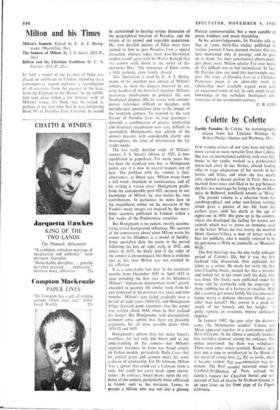Milton and his Times
Milton's Sonnets. Edited by E. A. J. Honig- mann. (Macmillan, 30s.) The Sonnets of Milton. By J. S. Smart. (0.U.P., 18s.) Milton and the Christian Tradition. By C. A. Patrides. (0.U.P., 42s.)
IN 1661 a model of the Garden of Eden was placed on exhibition in London, including (as a contemporary record explains) a reproduction of all creatures 'from the greatest to the least, from the Elephant to the Mouse.' As the exhibi- tion took place within a few minutes' walk of Milton's house, it's likely that he visited it, perhaps at the very time that he was composing Book IV of Paradise Lost. Certainly he would be accustomed to hearing serious discussion of the geographical location of Paradise, and the nature of its animal and vegetable population. His own detailed picture of Eden must have seemed to him to give Paradise Lost a special attraction, whereas today most post-Darwinian readers would agree with Sir Walter Raleigh that 'we cannot settle down in the midst of this enormous bliss.' The innocence of Eden seems a little pathetic, even faintly absurd.
This illustration is used by E. A. J. Honig- mann, in his excellent new edition of Milton's sonnets, to show the dangers incurred by any critic heedless of the historical situation. Milton's passionate involvement in political life and 'theological disputes fills his works with contem- porary references difficult to decipher, with metaphysical speculations alien to the temper of the twentieth century. To respond to the very flavour of Paradise Lost—its true greatness— demands a combination of precise scholarship and historical imagination now very difficult to accomplish. Honigmann's new edition of the sonnets presents with considerable clarity and thoroughness the kind of information the lay reader needs.
The last really detailed study of Milton's sonnets, J. S. Smart's edition of 1921, is now republished in paperback. For many years this has been the standard text, but, as Honigmann points out, it is now in several respects out of date. The problem with the sonnets is their allusiveness; as Smart says, 'Milton wrote from a full mind, abundant in reminiscence, and all his writing is woven close.' Honigmann profits from the considerable post-1921 increase in our knowledge of Milton; he also makes his own contributions. In particular, he notes how in the magnificent sonnet on the massacre of the Vaudois many images are inspired by the news- letter accounts published in London within a few weeks of the Piedmontese atrocities.
But Honigmann is no pedant, merely accumu- lating trivial background influences. His account of the controversy about when Milton wrote his sonnet on his blindness is a model of lucidity. Some specialists date the poem in the period following his loss of sight, early in 1652, and others in 1655, the likely date if the order of the sonnets is chronological, but there is evidence that at this time Milton was not crushed by his affliction.
It is a remarkable fact that 'in the seventeen months from December 1651 to April 1653 (a span including the first year of his blindness) Milton's "diplomatic decumentary work" greatly exceeded in quantity the similar work from his pen produced in the previous two years and nine months.' Milton's eyes failed gradually over a period of eight years (1644-52), and Honigmann brings forward good arguments that the sonnet was written about 1644, when he first realised his danger. But Honigmann, with characteristic common sense, admits that there are plausible arguments for all three possible dates-1644, 1651-52 and 1655.
Honigmann's edition does not make Smart's worthless, for not only did Smart add to our understanding of the sonnets—that Milton's apparent looseness in form was based strictly on Italian models, particularly Della Casa—but his critical grace and acumen make his work a classic of scholarship. For Dr Johnson, Milton 'was a genius that could cut a Colossus from a rock, but could not carve heads upon cherry- stones.' In contrast, Smart draws upon the evi- dence of the sonnets, particularly those addressed to friends such as the musician, Lawes, to present a Milton who was not just a gloomy Puritan controversialist, but a man capable of grace, kindness and much friendship.
In his acknowledgements, Dr Patrides tells us that in 'some thirty-five studies published in various journals I have pursued matters that are here mentioned only in passing,' and he goes on to thank 'for their constructive observations' just about every Milton scholar I've ever heard of. It's difficult not to feel intimidated. In fact, Dr Patrides does not need this heavyweight sup- port. His study of Paradise Lost as a Christian Protestant poem is an admirable work of scholarship, most carefully argued, even with an oceasional touch of wit; he adds much to our knowledge of the turbulent theological con- troversies of the seventeenth century.
C. B. COX


































 Previous page
Previous page